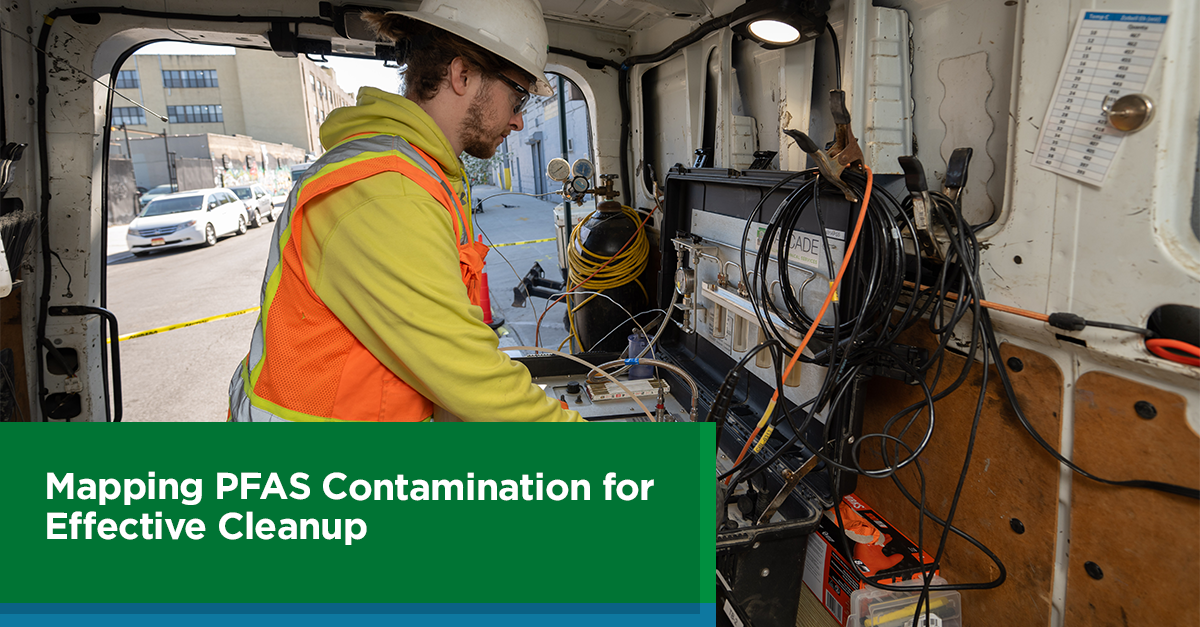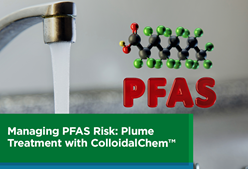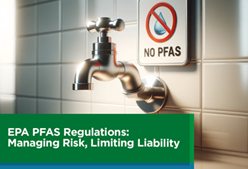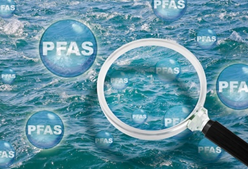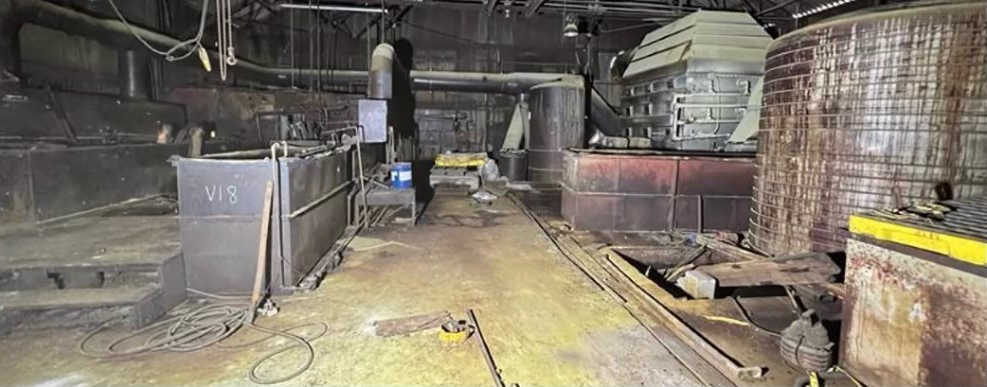EPA PFAS Regulations: Managing Risk, Limiting Liability
Per- and polyfluoroalkyl substances (PFAS) are a class of around 15,000 chemicals first commercialized in the 1940s. Since the late 1990s, these chemicals have come under increasing scrutiny due to their toxicity and widespread buildup in the environment. Recent studies show that 98% of Americans have elevated PFAS levels in their blood, linked to cancer, immune dysfunction, liver damage, and fertility issues. Because they don’t break down readily, PFAS chemicals are known as “forever chemicals,” contaminating soil, air, water, humans, and wildlife globally.
In response to this serious public health concern, the EPA has taken unprecedented action to research the impacts, restrict the production and release of PFAS, and require remediation wherever necessary. Understanding the rapidly evolving regulatory landscape is crucial for potentially responsible parties (PRPs) to manage risk today and limit liability in the future. In this post, we’ll overview how PFAS became a global problem, what steps regulators have taken, and how Cascade’s integrated services and expertise can help.
History of PFAS Chemicals and Emerging Liability
PFAS chemicals were developed and manufactured by DuPont and 3M beginning in the 1940s and quickly became ubiquitous in consumer products due to their unique properties—resistance to heat, water, and oil. Familiar household products include non-stick cookware coatings, water- and stain-repellent clothing, shoes, carpets, firefighting foams, and fast-food packaging.
The First Lawsuits
In 1999, the first PFAS (PFOA/C8) lawsuit was brought against DuPont by Wilber Tennant, a farmer who lost 190 head of cattle due to contamination from a nearby DuPont facility. This case led to a class action lawsuit in 2001, dramatized in the 2019 film, "Dark Waters," and recounted in the true crime book Exposure by Robert Billot.
The lawsuit revealed that DuPont knew about PFAS toxicity as early as the 1950s but failed to notify the public or regulators and did not adequately dispose of their PFAS waste.
Regulatory Awareness and Actions
The EPA became aware of PFAS issues in 1998, and by the early 2000s, numerous studies confirmed both the toxicity and widespread distribution of these chemicals. Today, there are over 5,000 known contaminated locations in the US, with thousands more suspected sources of PFAS contamination.
Since 2001, dozens of class action lawsuits and state actions have been filed against PFAS manufacturers, resulting in over $17 billion in awarded damages. Industry observers believe the cumulative total will eventually exceed $200 billion, on par with asbestos and tobacco settlements. Remediation costs for current known sites alone are estimated to exceed $100 billion.
New Regulations and Their Implications
Over 25 years after being made aware of PFAS hazards, the EPA has rolled out a comprehensive multi-agency approach that includes new regulations, actions, and reporting requirements under six regulatory frameworks: SDWA, CERCLA, RCRA, TSCA, EPCRA, and the CWA.
Key Regulations for PRPs
-
SDWA: The EPA issued a National Primary Drinking Water Regulation (NPDWR) for six PFAS, limiting perfluorooctanoic acid (PFOA) and perfluorooctane sulfonic acid (PFOS) to Maximum Contaminant Levels (MCL) of 4 ppt in drinking water, with MCLs of 10 ppt for perfluorononanoic acid (PFNA), perfluorohexanesulfonic acid (PFHxS), and hexafluoropropylene oxide dimer acid (HFPO-DA), known as “GenX.” The MCL Goal (MCLG) for these chemicals is set at zero, indicating no safe level of exposure.
- CERCLA: Polluters are held financially accountable for the cleanup of regulated hazardous materials. Five types of PRPs are affected by the new CERCLA rule: owners and operators of manufacturing facilities producing or using PFOA and/or PFOS, importers, processors, product manufacturers and downstream product manufacturers and users of PFOA- and/or PFOS-containing products, waste management facilities, and hazardous substance transporters.
EPA Multi-Agency PFAS Approach

While the new regulations focus on drinking water, their broader implication is that upstream source contamination must be addressed, including PFAS sources in soil contaminating groundwater and groundwater contaminated with PFAS migrating to impact drinking water sources.
Managing Risk and Limiting Liability
Every PRP that has made, used, transported, stored, or disposed of PFAS must now assess their risks and limit their liability. The scope of risks includes non-compliance with emerging regulations, unknown remediation costs, litigation risks, and potential insurance coverage denials.
Proactive Risk Management
To limit liability, proactive PRPs should work with experienced environmental consulting firms and trusted field service partners like Cascade to conduct comprehensive site assessments and develop remediation plans utilizing the most effective PFAS remediation technologies.
Advanced PFAS Remediation Technologies
Cascade has invested in developing advanced technologies for PFAS remediation:
-
ColloidalChem™ and ColloidalChem + Anchor™: This patented group of in situ remediation amendments use injectable colloidal activated carbon (3 µm) to sequester PFAS via adsorption, anchored with enzymes for PRB applications.
-
TerraTherm™ High Temperature Thermal Conduction Heating (TCH): This technology remediates PFAS in soils by heating contaminated soils until they react with naturally occurring metals to form inert compounds, capturing and destroying PFAS-related compounds in the vapor stream using a specially formulated catalyst.
PFAS Remediation – How Cascade Can Help
PFAS contamination is a significant environmental and public health issue, but it doesn’t have to be a forever problem. Cascade’s innovative technologies can fully remediate PFAS source zones and manage PFAS groundwater plumes. As the national leader in groundwater and soil remediation, Cascade offers comprehensive services and technologies across all project phases, from drilling and investigation through field implementation.
Contact us today to address your PFAS risk and remediation needs. Learn more about our solutions with the webinars and resources below.
About the Author

Eliot Cooper
Vice President of Technology & Business Development
Eliot Cooper is the Vice President of Technology and Business Development at Cascade. He specializes in designing efficient and cost-effective remedies using high-resolution site characterization (HRSC) and a wide array of remediation options. Eliot’s expertise lies in finding the right combination of tools and technologies for complex sites, ensuring every step of the remediation process is optimized for results.

